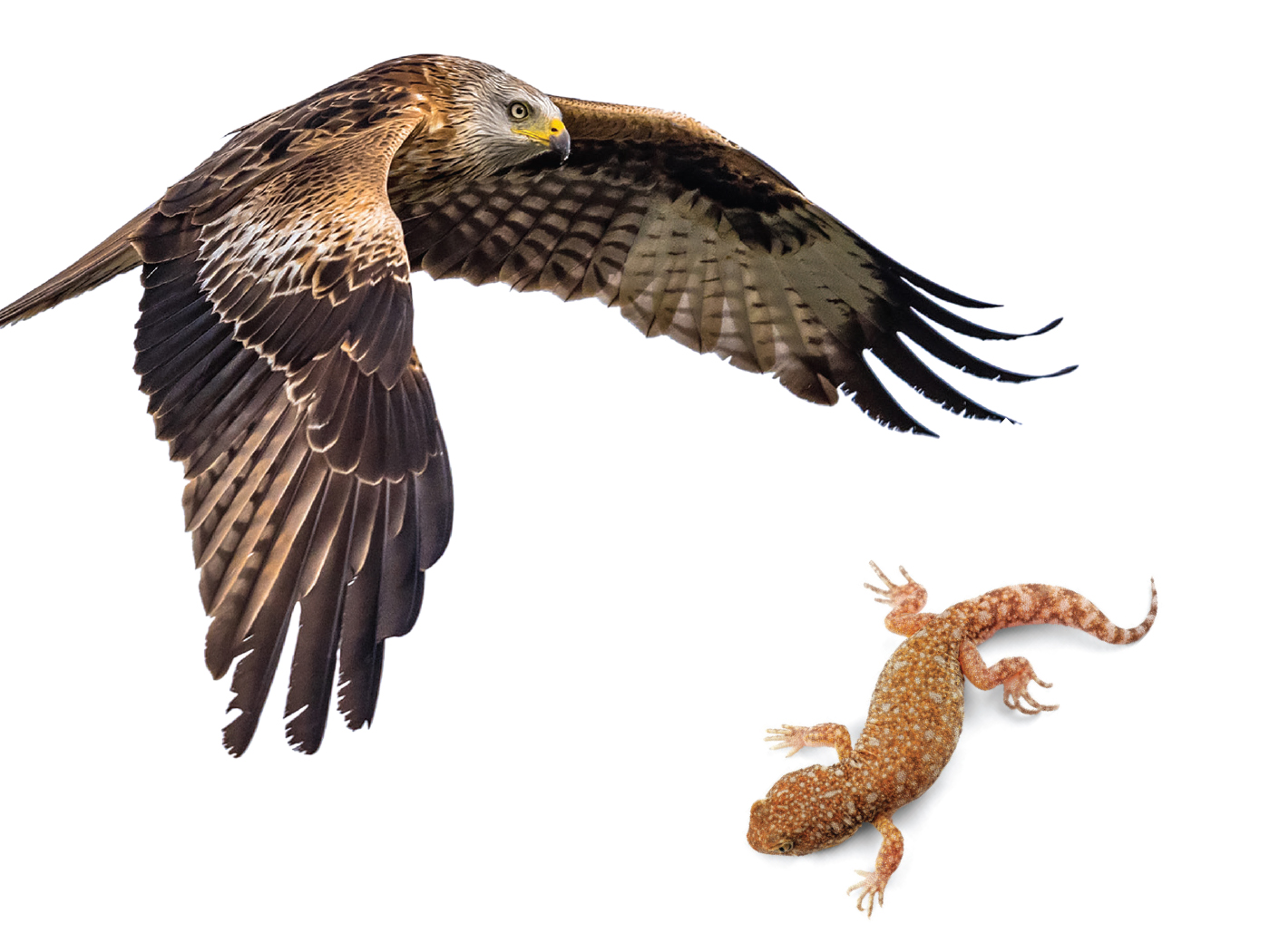Located on the Equator about 600 miles from the coast of Ecuador is a set of volcanic mountains that emerged from the Pacific Basin. They were first named Las Islas Encantadas or, "the Bewitched Islands," but now are universally given the name Galapagos in reference to their most unique resident, the giant Galapagos tortoise. The Galapagos archipelago (a chain of many islands) is made up of thirteen major islands, six smaller islets, and fifty still smaller islets and rocky formations. These islands were on the 1835 itinerary of the H.M.S. Beagle when it stopped for five weeks with its now famous naturalist, Charles Darwin.
The Daphne twins, Major and Minor, are islets situated north of Santa Cruz Island near the center of the main Galapagos cluster. These islets have been closed to the public for the most part due to erosion and research. Daphne Major has been the site of a long-term ecological research program (now 24 years) conducted by Peter and Rosemary Grant of Princeton University. "The Grants are the gurus of Darwin's finches."1 They have been studying the Daphne endemic finch population since 1973. With great detail they have been catching, assessing, banding, and releasing generations of finches in an effort to explain Darwin's "mystery of mysteries."2
Darwin's Finches
Darwin himself did not actually visit Daphne Major but collected many specimens for later study. The English ornithologist John Gould had classified Darwin's Galapagos finch collection of thirty-one specimens. Thus, the collection became the basis for Darwin's developing ideas (post voyage) of speciation as the mechanism for evolution. Darwin wrote,
Of land-birds I obtained twenty-six kinds, all peculiar to the group and found nowhere else, . . . The remaining land-birds form a most singular group of finches, related to each other in the structure of their beaks, short tails, form of body, and plumage: there are thirteen species which Mr. Gould has divided into four sub-groups. All these species are peculiar to this archipelago, and so is the whole group. . .; but all the other species of this group of finches, mingled together in flocks, feed on the dry and sterile ground of the lower districts. . . . The most curious fact is the perfect gradation in the size of the beaks in the different species of Geospiza, . . . Seeing this gradation and diversity of structure in one small, intimately related group of birds, one might really fancy that from an original paucity of birds in this archipelago, one species had been taken and modified for different ends.3
The Need for Variability
It was this wide range of variation in beak size that caught the Grant's attention as they gathered feeding, breeding, and morphometric data about these birds. Weiner wrote about the research,
Grant wanted to watch what actually goes on in nature. What he needed [in the early 1970s] was a group of hypervariable species, well studied, variably variable, scattered across a set of remote and undisturbed locations. "The Galapagos were ideal," he [Grant] says, "Darwin's finches were ideal."4
What is surprising in this research story is the clear presentation of evidence, yet curious disregard of its implications. Weiner states,
You can't distinguish these three species by their plumage and usually not by their build or body size either. You have to tell them apart by their beaks. In the jargon of taxonomy, the sullen art of classification, the beak of the ground finch is diagnostic: it is the bird's chief taxonomic character. But because the finches and their beaks are so variable, many of them "are so intermediate in appearance that they cannot safely be identified-a truly remarkable state of affairs. . . ."5
"At the Charles Darwin Research Station on the island of Santa Cruz, the staff has a saying: 'Only God and Peter Grant can recognize Darwin's finches.'"6
What is a Species?
At this point a definition of species is important, because Peter Grant may not always be around to tell the finches and their hybrids apart. Endler summarized an international symposium on speciation held in the late 1980s by saying,
Species are "tools that are fashioned for characterizing organic diversity" (Lewin, 1979). Just as there are a variety of chisels made for different purposes, different species concepts are best for different purposes; and just as it is inadvisable to use a carving chisel to cut a mortise, problems arise when one species concept is used when it is inappropriate. Confusion and controversy have often resulted because different people working with different groups of organisms mean different things by "species."7
Nelson, as part of the same symposium, likewise acknowledges that a satisfactory definition for species is hard to come by,
At the outset I confess a disbelief in species, as that word is commonly understood to refer to the basic taxonomic unit of evolution. Still taxa are real.8
What seems to be the situation is that there are many definitions for the term species, but their validity depends upon the purpose of the user. Such a plastic concept is good for nothing. It only adds to the dilemma of macroevolution which has never been seen, has no known mechanism for operation, and now has no agreed upon basic unit to start from. This situation is inherent in the interpretation of the Grants' research on Darwin's finches.
The Impact of El Nino
Research in the period 1973-1982 on Daphne Major was fairly typical of field studies until the "big one," a super El Nino, hit the Galapagos in January of 1983. Unusually warm water in the eastern Pacific stirred up a rainy season like none other before it. These desert islands became almost tropical with plant abundance and bird food was plentiful. In turn breeding was frequent and productive such that by June there were more than two thousand finches on the island.
More important than the rush of matings within species was the hybridization between species of Ereospiza. A scandens male mated with a fortis female and produced four viable offspring. Three of the hybrids mated to produce forty-three grandchildren. In yet another hybridization, a fuliginosa female mated with a fortis male, and they now have great grandchildren.
"But since 1983, which can truly be called a watershed year, the hybrids have done better. Those that hatched after that year were more likely to breed. They were also slightly more successful than the offspring of purebred fortis or fuliginosa pairs. And these odd couples went right on producing for the rest of the 1980s."9
"Crosses between fortis and scandens, the medium beak and the cactus finch, are doing better yet."10
What do you suppose the Grants made of that? Certainly they would have observed that these three species are really only one species if they can interbreed and produce offspring that are fitter than their parent species which were successful up to that time. However, they concluded,
Hybridization is evolutionarily important because it produces novel combinations of genes . . . thereby creating favorable genetic conditions for rapid and major evolutionary change to occur. . . . 11
Did they see a new species form? No. Rather they saw despeciation or fusion of species implying that the original "species" were really parts of one highly variable gene pool. In spite of the evidence, Weiner presents a new synthesis to explain the observations.
Reticulate Evolution
"To the Grants, the whole tree of life now looks different from a year ago. The set of young twigs and shoots they study seems to be growing together in some seasons, apart in others. The same forces that created these lines are moving them toward fusion and then back toward fission."12
"The Grants are looking at a pattern that was once dismissed as insignificant in the tree of life. The pattern is known as reticulate evolution, from the Latin reticulum, diminutive for net. The finches' lines are not so much lines or branches at all. They are more like twiggy thickets, full of little networks and delicate webbings."13
Conclusions
For years evolutionists have been looking for compelling examples of species divergence with gradual or cataclysmic separation of populations that could serve as founder populations for incipient species. Now, the Grants are proposing just the opposite -- that when species fuse, they give rise to hybrid vigor that is the basis for new beings.
So, we have another new theory to add to the list of hopefuls: Lamarckian evolution; neo-Lamarckian evolution; Darwinian gradualism, neo-Darwinian evolution; punctuated equilibrium; Wright's shifting balance theory of evolution; theistic evolution; orthogenic evolution among others, and now reticulate evolution. Which one of these nine represents "The fact of evolution"? If we put the biological species test to reticulate evolution, we believe it establishes that the hybrid finches and their parents can be nothing more than varieties of a single polymorphic species.
REFERENCES
1 J. Weiner, The Beak of the Finch (New York, Alfred A Knopf, Inc., 1994), p. 19.
2 C. Darwin, The Voyage of the Beagle (New York, Penguin Books, USA, Inc., 1988), p. 326.
3 Darwin, pp. 327-8.
4 Weiner, p. 43.
5 Weiner, p. 43.
6 Weiner, p. 43.
7 J. Endler, Conceptual and Other Problems in Speciation in D. Otte and J.A. Endler, Speciation and Its Consequences (Sunderland, Massachusetts, Sinauer, 1989), p. 625.
8 G. Nelson, Species and Taxa: Systematics and Evolution in D. Otte and J.A. Endler, Speciation and Its Consequences (Sunderland, Massachusetts, Sinauer, 1989), p. 60.
9 Weiner, p. 124.
10 Weiner, p. 125.
11 P. Grant and B. Grant, Hybridization of Bird Species, Science 256 (1992), p. 197.
12 Weiner, p. 200.
13 Weiner, p. 201.* Dr. Kenneth B. Cumming is Dean of the ICR Graduate School and Professor of Biology.




















